Russia Update 5
UST NERA TO KHANDYGA
February 28, 1996

This was the Siberia we had dreamed of. Snowcapped peaks stabbed into an Arctic sky. The road here was hard-packed ice. It became narrow and treacherous as we climbed through and over these mountains.
In the remote mountains of Northeastern Siberia, between the Cherskogo range and the Verkhoyanskiy range, there are valleys which, for reasons better explained by meteorologists, experience cold beyond imagination. As the dry Arctic air rushes down from the Laptev Sea, temperatures can plummet below -60° F for weeks. At least four small communities vie for the title of “The Coldest Inhabited Place in the World”. Near Oymyakon, a monument was placed to mark the spot, but their record of -96.4° F has been eclipsed by a low of -98° F, and rumors of -112° F in Verkhoyansk were circulating. Ust Nera, (64° 34′ N /143° 13′ E), is in the running, with a low of -97° F. Minus ninety-seven is one hundred and twenty-nine degrees below freezing!!
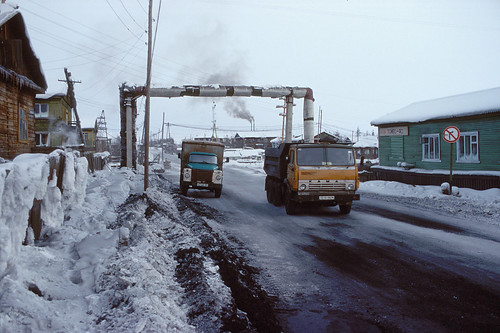
Since most homes are heated from a central coal-burning power plant producing hot water, the town was crisscrossed with a web of raised insulated pipes.
Ust Nera was a Gulag (prison labor camp) until 1956, part of Stalin’s Dalstroy organization which claimed as many as 20 million Russian lives. Now an active gold mining town, it is situated in a wide river valley, guarded by high peaks and ridges capped with unique jagged rock formations resembling the backbones of dinosaurs. The whole settlement is built on permafrost, a layer of frozen soil hundreds of feet deep which never melts. Newer buildings were constructed on stilts so that their heat wouldn’t thaw the earth below, but older log homes have sagged and settled into the ground at drunken angles. Since most homes are heated from a central coal-burning power plant producing hot water, the town was crisscrossed with a web of raised insulated pipes.
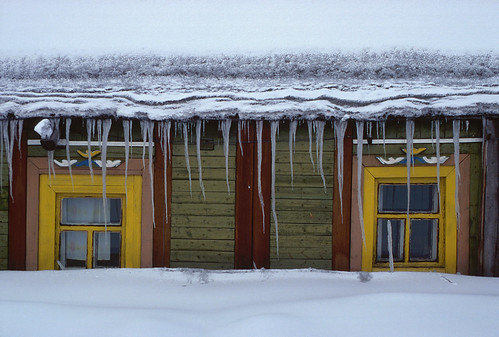
In Ust Nera, we began to see a classic element of all Russian homes in villages; their unique individually painted and carved window frames.
With the help of our truck-driver friends at the “auto base” and the Ust Nera Mining Company, it took us only three days to organize a convoy to Khandyga (62° 39′ N /135° 32′ E), the next stepping stone on our way across the Russian Far East. To travel alone across this part of Siberia is to invite disaster. Our Russian friends wouldn’t hear of it. We were convoying with two tanker trucks going to pick up a load of diesel for the mines. The trucks were older six-wheel drive Krazes. The drivers, Yuri, 51, and Misha, 56, had many years of experience on the Ust Nera-Khandyga winter route. They were excited that we would be joining them for the two-day trip.

This six-wheel drive Kraz tanker was typical of the trucks we convoyed with. Russian truck drivers were a friendly bunch, and they loved what we were attempting to do.
By the appointed time of 8:00 AM we were ready to roll, but it was 10:30 before we left. Just outside of town we parked with Yuri to wait for Misha. Both our main fuel tanks were empty, but Yuri assured us that as soon as Misha arrived, we could fill up from his reserve. We were running on fumes. I tried turning off the engine, but at this temperature, I could watch the needle drop. Rather than use any of our 100-gallon stash of jet fuel in the support trailer, I decided to dump in one of the jerry cans off the back rack. We had filled it in Magadan with what we were told was “saliarka arctic”, (winter diesel). When I tipped the can up however, nothing came out! The spout was full of what looked like tapioca pudding. I had not added any Red Line Anti-Gel.
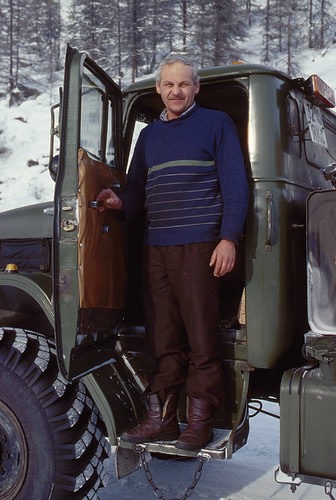
Yuri drove one of the tankers we traveled with from Ust Nera. On the return, his truck lost a clutch. He waited on the side of the road, engine running 24-hrs a day, in temperatures down to -80°F at night, for five days. He could not leave his truck alone.
Just then Misha arrived. We filled up with his siphon hose. It was almost 2:00 PM before we actually got underway. Shortly after leaving town, we began a steep climb into the mountains. For the first time, we saw stands of birch mixed into the larch and pine. The view from the pass at 4,530 ft. into the Nera Valley and across snow-covered peaks in all directions was spectacular. Misha had brought his own video camera, and he had a good eye for pictures. We were able to stop frequently.
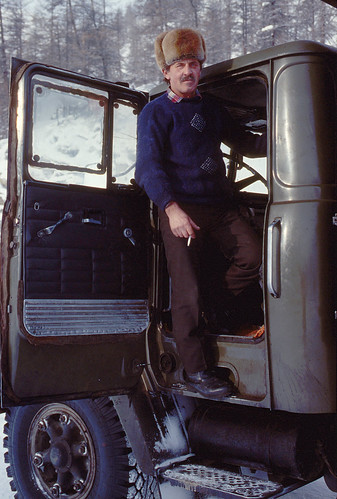
Micha drove the second truck out of Ust Nera, hauling fuel back from Khandyga. He brought his own video camera, and stopped frequently when he saw a good shot for us to film.
The road was a narrow single lane, with just room to pass now and then. It was icy in spots, but a little coal ash had been spread on the worst hills. We had to keep a constant watch for trucks. If they stopped coming up, they might not have been able to start again on the slick surface. Stopping quickly on the downhill was impossible, or at best, extremely dangerous.
As we were now accustomed, there were detours around most bridges. On some occasions, we’d bypass whole sections of road by driving down rivers, over islands and through the forest. The tracks were easy to follow, but required four-wheel drive most of the time. The gravel “worm piles” of dredge mining continued to scar the river beds with alarming indiscretion for the natural beauty of the land, but perhaps no worse than those in Canada’s Yukon or California’s gold country.

In the sub-zero temperatures of the Siberian Winter, wooden bridges like this are bypassed whenever possible. Perhaps the brittle timbers could crack in the extreme cold.
Seventy-eight miles out of Ust Nera we passed the entrance to a large mining operation. The traffic, which had been two or three trucks every half hour, was reduced to almost zero. The track from here to the junction with the road from Magadan to Yakutsk is a winter road. Though some sections were under construction, locals said it would be years before it could be driven year-round.
Our late start again forced us to travel after dark. In the beams of our PIAA 80 PROs, the trail looked like a two-lane bobsled run of gray glare-ice. The surface was very rough with irregular dips and holes. Our support trailer yanked at the back of the truck like a mad pit bull lunging at its chain as it leaped in and out of the track.
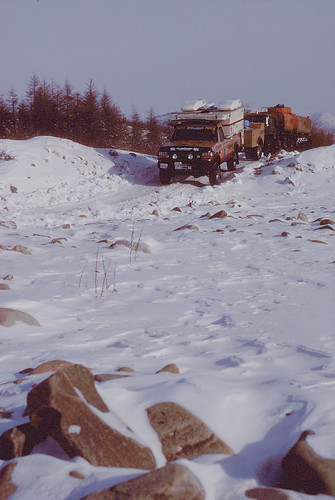
As evening fell, we drove down a rocky embankment onto a frozen river. Our clearance was several inches less than the big Krazes, so we had to judge boulders carefully.
The inky vacuum of night swallowed everything but the path of our lights as we traversed a narrow berm across a frozen marsh for several miles. In the black void, an 8-foot drop-off on each side waited hungrily for a mistake. Two trucks had slid off and overturned. They would stay there until the end of Winter.

Driving up this narrow river was a strange experience. We could see where the water had boiled over submerged boulders as we twisted through the frozen rapids.
Leaving the berm, the track dropped down into a gully and made a hard right up a steep hill. I stayed to the right out of habit.When I felt the wheels slipping, it was too late. A 6×6 Kamaz truck blasted by us out of nowhere, blocking my escape to the left. With all four wheels locked, the truck and trailer began a slow helpless slide backwards and sideways down the hill. The trailer’s inertia brakes were useless, and it began to jackknife. After several feet, the truck found some snow and stuttered to a stop. By locking up only the front differential, I was able to spin/crab the wheels sideways enough to straighten out the trailer and back down for a second try.
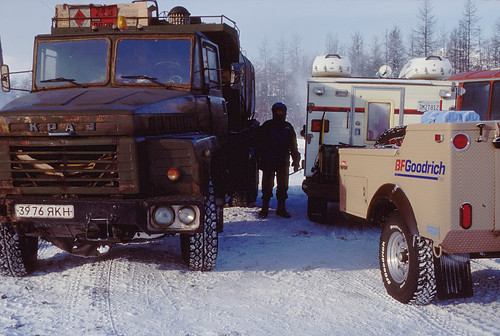
We never had to touch the 100-gallons of jet fuel in our support trailer between Ust Nera and Khandyga. Micha siphoned diesel out of his 500-gallon reserve whenever we needed it. The quality of the Russian fuel seemed to be fine for our Power Stroke engine.
The treacherous track continued to roller-coaster through the trees. Eerie shadows played in the forest as we climbed slowly to a pass at 4,470 ft. and descended gradually to the town of Kyubyume (63° 26′ N /140° 30′ E), parking on the ice of the Kyubyume River to camp for the night. Kyubyume was the junction of The Road of Bones, the normal route from Susuman to Khandyga.
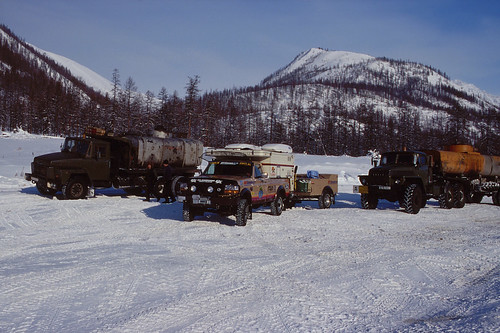
Along the route from Ust Nera to Khandyga, there were parking areas where trucks could stop for the night or a rest break. There are no flying J’s or Pilot truck stops in this part of the world.
Following what would become a standard procedure, we stopped, waited five minutes, moved forward a foot, waited another five, and moved a second time, allowing the tires to cool and prevent them from freezing to the ground overnight. Though we had far exceeded the official minimum temperature rating for our BFGoodrich T/A Mud-Terrain tires, (their glass transition point is -40° F), we saw no signs of cracking or loss of pressure. Perhaps the special natural rubber racing inner tubes we had installed at the advice of the BFGoodrich engineering department were working, or perhaps they had not been necessary. Who would take a chance? We had no concern for our Alcoa hot-forged one-piece aluminum rims. They become stronger in sub-zero temperatures.
We crawled into our camper and whipped up a one-pot meal using canned meat, canned butter, instant rice and Alpine Aire freeze dried vegetable mix. The temperature when we stopped was -64° F. By morning, it would drop to -87° F!!
We had planned to keep the engine block and oil warm using 110-volt heaters powered by our Coleman Power Mate diesel generator, which consumed a fraction of fuel the truck would if left running all night. In Ust Nera however, we had noticed that while the engine started easily in the morning, the power steering whined and pulled as the pump struggled to move the thick jelled mass through the lines. The gear shift lever was stiff. After a ten minute warm up, there was a tell-tale spot of power steering fluid on the snow; not a good sign. The Zerostart block, oil and battery warmers were not keeping the belts and other external parts of the engine warm.
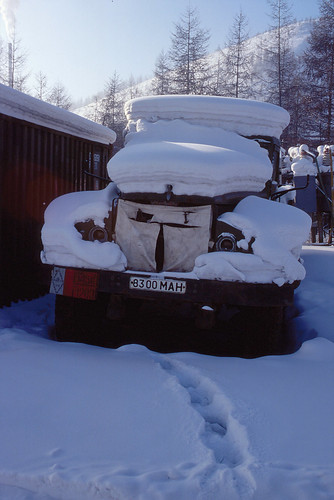
In Eastern Siberia, where temperatures seldom raise above -30°F in the Winter, once a truck like this is turned off for more than an hour, it will not be started again till Spring.
Following the Russians’ practice, at anything below -40° F (-40° C), we now left the engine running 24-hours a day, and the Deflecta Shield Wintershield on the grill completely closed. This allowed us to keep the camper warm by using only the Hunter HW-6 12V hot water heater which is plumbed to the engine’s cooling system. Set on medium, with the camper’s top down, the inside air temperature remained at 65° F to 75° F, making our Cascade Design R-0° sleeping bags almost too warm. Nevertheless, hot water or coffee spilled on the floor would freeze instantly. Snow melting off our LaCrosse Ice Man winter boots created a small glacier by the door.
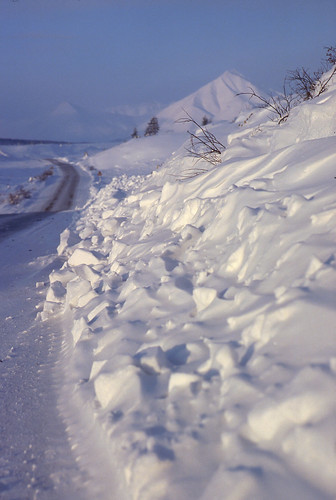
As we dropped into a valley on the approach to Khandyga, the wind-blown snow on the roadside looked like fresh whipped cream. The air was extremely dry and clean.
The next morning was clear and bitter cold. Despite our precautions, we still needed low-range to break the tires loose. The road was better now. Daylight helped. For the first ten minutes, we crept along at three or four mph, allowing gear oil and transmission fluid to liquefy. This section was part of a proposed all-year route from Magadan to Khandyga but it is perpetually under repair or construction. As we wound our way up the drainage of the Kyubyume River over a low pass and down into the valley of the Vostochnaya (East) Khandyga River, open trucks stacked with frozen quarters of beef passed us. At -70° F the meat was not likely to spoil. We wondered morbidly if this was how they transported the victims of the Gulags to their final resting place, now under the wheels of our truck! Was this really “The Road of Bones”?
Stopping for lunch, drivers boiled up a pot of tea on a kerosene stove and ate bread and sausage or frozen fish. At night, they slept across their front seat. There are no plush sleeper cabs, and no Flying J or Texaco Truck Centers in this part of the world.
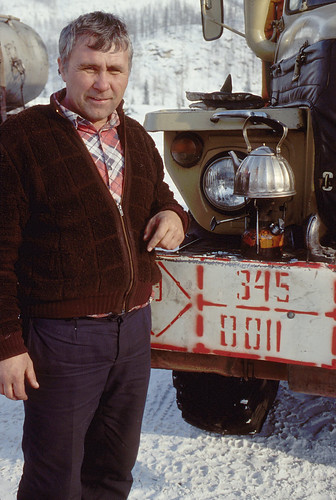
No fancy truck stops in this part of the world. A kerosene stove heats a tea pot for a quick lunch break on the road.
The main track here had been cut along the cliff above the river, but since we were headed towards Khandyga, and therefore presumably empty, we were diverted onto the river bed itself. The next few miles were fascinating as we drove downstream. This was a small tributary of the Vostochnaya Khandyga river, perhaps only fifteen yards across in places with a fast drop. We could see the frozen boils where the rushing water had heaved up over rocks as we “ran the rapids”. Cracks in the blue ice had formed miniature crevasses several feet deep.
Crossing an old wooden trestle, we waited at the bottom of the Tchorny PrishiÎm grade while two fuel trucks inched their way down the one-lane ledge carved into the rock cliffs. On-coming truck drivers, always in convoy, would hold up one finger to their eye, indicating the need to watch for others coming behind them. Snowy peaks towered ominously above our heads. A thousand feet below, a wide river with many islands meandered down a beautiful valley. Walls of snow from earlier avalanches reached higher than the camper. In the dead of Winter, it was a picture off an old Christmas card, the snow piled high like globs of shaving cream. You know it could never look like that, but it did.
Three hundred miles from Ust Nera we dropped into the flat land leading to Khandyga. The peaks of the Sordoginskiy range crowded in from the north. The road straightened out and was slightly faster. There were short hills, and about halfway up each grade, a small sign marked a pile of coal ash or dirt buried under the snow. If trucks got stuck on the ice, it was a do-it-yourself-with-your-own-shovel road maintenance program.
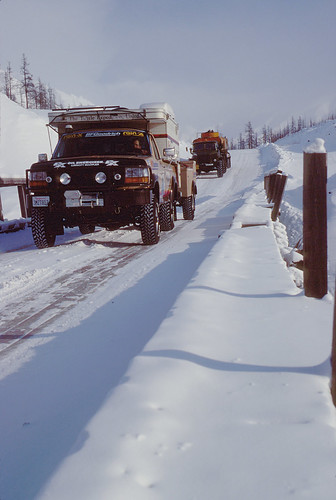
As we crossed an old trestle, Yuri stayed a safe distance behind. Only one truck at a time could cross these wooden spans. More often, the road would drop onto the frozen river to bypass bridges.
Darkness had fallen when we stopped just out of Khandyga for the night. The four of us squeezed into the cab of Misha’s Kraz and ate frozen raw fish, dark Russian bread, Velveeta cheese & dried fruit from sunny California, all washed down with Ukrainian vodka. It had been a great two days. We are starting to get used to temperatures which seldom rise above -40°F (-40°C).
SUMMARY
Mileage from Ust Nera to Khandyga: 357 (575 km).
Total driving time: 20 hours.
Average speed: 17.8 mph.
Road condition: Mixed, from reasonably good packed snow to one-lane ice to one lane with deep drifts and high center berm. Volleyball-size rocks on river gravel bars present a clearance problem even for a pick-up. High clearance and four-wheel drive was mandatory on steep icy passes and areas with deep snow. Holes in river ice can be dangerous. This is not a drive for anyone afraid of narrow icy mountain roads with steep, deep drop-offs and no guard rails. There is no fuel along this two-day route, and engines must be left running all night.







